Hydraulic Fracture in Highly Permeable Rock
November 29, 2022
COLUMBIA UNIVERSITY
New York, NY USA
Speaker:
PROF. EMMANUEL DETOURNAY
Department of Civil, Environmental, and Geo-Engineering
University of Minnesota
Abstract: Models of hydraulic fractures in conventional reservoirs assume that Carter’s leak-off law —the leak-off rate is proportional to the inverse of the square root of the time elapsed since exposure to fracturing fluid — is applicable. The validity of Carter’s leak-off law stems from the cake-building properties of the fracturing fluid. In some situations where water is essentially the fracturing fluid, Carter’s leak-off law can also be justified (through a reinterpretation of the leak-off coefficient) as an early-time solution of the diffusion equation. However, in water flooding operations of very permeable poroelastic reservoirs, the fracture propagates in a region where the pore pressure perturbations caused by injection of water is quasi-stationary. The talk will present the construction of a new class of solutions for hydraulic fractures propagating under these particular conditions. In particular, the existence of two asymptotic fracture propagation regimes is demonstrated: rock-flow dominated at small time and fracture-flow dominated at large time. The timescale that legislates the transition between the small and large time asymptotic regimes is shown to be a strongly nonlinear function of a dimensionless injection rate. The rock-flow dominated regime is characterized by an increasing injection pressure while the fracture-flow dominated regime is associated with an injection pressure decreasing with time. The peak injection pressure takes place during the transition between the two regimes.
Bio: Emmanuel Detournay is currently the Theodore W. Bennett Chair Professor in Mining Engineering and Rock Mechanics in the Department of Civil, Environmental, and Geo- Engineering of the University of Minnesota (UMN). He holds a mining engineering degree from the University of Liège, Belgium and MSc and PhD degrees in Geoengineering from the UMN. Prior to joining the UMN faculty in 1993, he held various positions in consulting companies (Itasca, Minneapolis, MN; Agbabian Associates, El Segundo, CA) and in R&D (Dowell-Schlumberger, Tulsa, OK; Schlumberger, Cambridge, England). His expertise is in petroleum geomechanics, with two current research focuses: drilling mechanics (bit/rock interaction, self-excited drilling vibrations, drillstring/borehole interaction, and directional drilling) and mechanics of fluid-driven fractures (asymptotic analysis, scaling, numerical modeling). He has co-authored about 140 papers in refereed publications. He has also been awarded 8 U.S. patents and has received several scientific awards for his work. In 2016, he was elected into the U.S. National Academy of Engineering.
The Maurice A. Biot Lecture was established at Columbia University in 2004 in remembrance of the late Professor Maurice Anthony Biot and his renowned achievements as an engineer, physicist, and applied mathematician. Biot was a professor of mechanics at Columbia University in the period 1937-1945.


